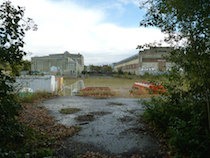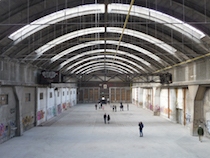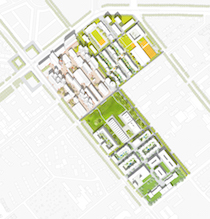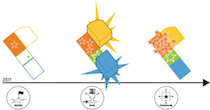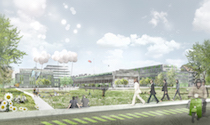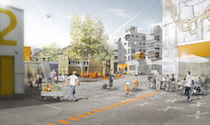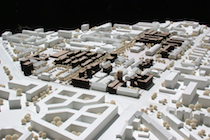Back to territory. Positions and forms of sustainability in Germany edited by Jörg Schröder and Maddalena Ferretti, with Claudia Di Girolamo
torna suKreativquartier München. Verena Schmidt, Urs Kumberger 
Development framework plan for a mixed-use neighborhood on a former military site north of Munich center, (2013-2014) as a result of an international ideas competition, 1st prize (2012), Client: City of Munich, Department of Urban Planning and Building Regulation
Area: 20,2 acres / Floor Area: 170.000 m² / Program: 900 apartments, university, kindergarten, primary school, office space, creative and cultural uses
SITUATION: A niche in the urban context
Munich is the most densely populated city in Germany. Its population is growing constantly and new affordable housing is urgently needed.
Northwest of Munich Maxvorstadt is the 20-acre future site of the KREATIVQUARTIER which will be opened for new development in the near future. It is characterized by its central location between the Olympic Park, downtown Munich, Maxvorstadt and Neuhausen.
A portion of the site was used for military purposes until 1920 and then it was adapted for industrial and municipal businesses. Following the gradual displacement of these companies, temporary users from the fine arts and cultural scene settled in the unused spaces. The unpretentious existing buildings, ranging from small-scale storage rooms to spacious halls, became the nucleus of a vibrant culture of interim uses with studios, dance workshops and independent theaters. The buildings in the north-west of the quarter stand out of the homogeneous fabric of the city. The surrounding streets, spaces, and urban wilderness create an atmosphere which is considered a particularly special quality worth preserving. Regarding its spatial and creative potential, the site represents a unique niche in the context of Munich. However, the rare informal qualities are confronted with an enormous development pressure on inner-city locations. In the long-term, the area is planned to become a mixed-use neighborhood with 900 apartments, university buildings, offices, as well as creative and cultural uses. The current temporary uses offer a starting point for new activity. The challenge is to meet the huge demand for new apartments without losing the specific character of the site.
GOALS: Diversity at all levels
The project seeks to establish a new planning culture, which puts social and urban values ahead of purely monetary interests. Important foundations for an urban living environment are:
_Social, spatial and atmospheric diversity
_Appreciation of existing qualities and resources
_Opportunities for appropriation and identification
_Differentiated and affordable spaces
_Diverse public spaces
STRATEGY: A pressure-release-valve for development
The quarter is read and developed as four modules:
_The PLATFORM as urban interface of college campus and compact living
_The FIELD as a green residential and educational area
_The LABORATORY as urban experimentation space for creative uses
_The PARK as central public space of the neighborhood—planned in conjunction with the new cultural center in the Tonnen- and Jutierhalle, which will have citywide importance.
Existing qualities will be defined and worked out specifically during the process. The areas of the PLATFORM and the FIELD have unused spaces that can be transformed without displacement conflicts. The rapid densification of these two modules produce a large part of the housing needed and relieve the pressure for development of the entire neighborhood, particularly from the LABORATORY and the PARK, which are currently being used. This gives space and time for a careful transformation of the existing buildings in those areas. The speeds of development and the density of the blocks are regulated on a case-by-case basis. In this way, the planning strategy gives leeway for a formation of atmospheric and programmatic diversity.
LABORATORY: An urban experimentation area
The LABORATORY is already in an informal development process. The transformation is continued in a processual way in order to respond to the situation. The slowly developed morphology of the site and its specific use create a unique atmosphere. A maximum of both buildings and uses will be preserved and redefined. The existing buildings will be densified or replaced plot by plot. The typology of new construction will pick up spatial elements of the existing ones. The basic module is a hall that offers space for creative and public uses within a flexibly dividable ground floor zone. This multifunctional base is combined with individual build-ups. In this way, innovative uses such as hybrid combinations of living and working are encouraged. The planned building settlement is based on a framework analog to the existing footprint and spatial structures. The transition between inside and outside is immediate and without enclosures, or fences. Because of this, an extension of the building-use in the outdoor space is made possible. The outdoor areas have a high degree of paving, which brings forward accessibility and usability. The result is public space that is open for appropriation and encourages people to work and interact outdoors.
PARK: The central public space of the neighborhood
The PARK surrounding the impressive Jutierhalle and Tonnenhalle is the center of the district. This generous open space in front of the halls offers space for communication, recreation and culture. The open front of the park to Dachauer Straße and Heßstraße enhances the visibility of the quarter beyond its boundaries. Due to public appropriation of the open space, a highly multifunctional space of opportunities is already developing there that differs from typical parks in its rough character.
FIELD: A green residential and educational area
In the FIELD, buildings and functions are linked by differentiated outdoor-spaces. The rows of houses form a sequence of quiet residential streets and residential gardens, which are provided under the ownership principle of the commons for community use.
PLATFORM: An urban interface of college campus and compact living
The PLATFORM is an urban interface between education, housing and working. New residential buildings are planned along the quiet Heßstraße and following the existing building pattern. Their ground floors offer space for office and retail uses. Three additional faculty buildings will complement the university buildings in the south of the district. According to the existing structure in the environment of Lothstraße, the university is not understood as a closed campus, but as part of the city.
TOOLS: Planning and Regulation
The realization of the concept, particularly with regard to the LABORATORY, requires special tools and methods of communication. The development does not follow a predefined final image, but is driven by a context-specific, procedural strategy. Institutionalized formats of planning are re-conceptualized in favor of open, collective processes.
The DEVELOPMENT FRAMEWORK PLAN combines spatial and organizational approaches to the project. Unlike a rigid master plan, it integrates operative and temporal components. The individual tools form the basis for all subsequent planning processes.
The MANUAL formulates guidelines for the handling of public space as well as existing and new buildings. Parameters such as density, the mix of uses and typologies can be regulated with the overall concept in mind in order to promote the desired diversity and urban qualities.
The MILESTONES define a time-frame in order to structure the open development process of the LABORATORY. In each stage several existing buildings are transformed or replaced, depending on their structural condition, as well as their ideational value. At regular intervals, an advisory committee of experts and stakeholders evaluates the status-quo, discusses prospects and incorporates the results into an ACTION PLAN.
DIALOGUE: Process Design, Use and Participation
A neighborhood with a strong identity can arise when local actors are involved. Existing uses and slowly developed networks are respected and integrated into the new development. Because of this, COMMUNICATION and PARTICIPATION play a crucial role in the process. An organizational committee with a COORDINATION OFFICE ON SITE moderates interaction and collaboration between politicians, designers, administrations, stakeholders and the neighborhood.
The possibilities for further interim uses will be explored based on an intensive inspection of the existing buildings within the area of the LABORATORY. Costs are limited by the definition of simple building standards in order to generate low-economic-thresholds for creative uses in the long run. In addition, new constructions with innovative programs and financing models should contribute to the diverse character of the neighborhood.
The PARK, with the landmark Jutierhalle and Tonnenhalle buildings, presents another particularly representative module of the cultural program. An area of approximately 6,000 square meters within the existing industrial buildings will be rearranged for cultural and creative uses such as ateliers, co-working spaces and a performing arts center. The interdisciplinary ideas competition "Kreativen Raum schaffen" was implemented to develop a programmatic and operative concept for this special location.
The participation process is an integral part of the overall development. It is accompanied by public events and workshops, which are partially funded by the National Urban Development Policy.
SUSTAINABILITY: A holistic approach In order to develop a forward-looking, contemporary neighborhood, a holistic understanding of sustainability is needed - one that takes into account social, atmospheric and ecological aspects. The project focuses on a dense urban layout, energy-efficient construction and a progressive mobility concept. In addition, the sustainability concept attaches importance to existing resources such as buildings, uses and social networks. Since embodied energy should be calculated in the energy concept, the preservation and reuse of existing buildings provide a great ecological benefit. Furthermore, those buildings foster social sustainability by offering identification points and affordable space for broad target groups. Especially in the LABORATORY, the reuse and interim use of existing buildings helps to generate a vivid and sustainable neigborhood.
Authors (Text): Verena Schmidt, Urs Kumberger
Architects: TELEINTERNETCAFE Architektur und Urbanismus, Berlin
Landscape Architect: TH Treibhaus Landschaftsarchitektur, Hamburg
Expert Planners (Development Framework Planning): ARGUS, Hamburg (Traffic Planning), LÄRMKONTOR, Hamburg (Noise Control), Prof. Dr. SIEKER, Berlin (Rainwatermanagement), TRANSSOLAR, Munich (Sustainability)
Consultants (Competition Team): TRANSSOLAR, Munich (Sustainabilty), Lukas Feireiss (Culture), Maike Brammer (Interim Uses)
